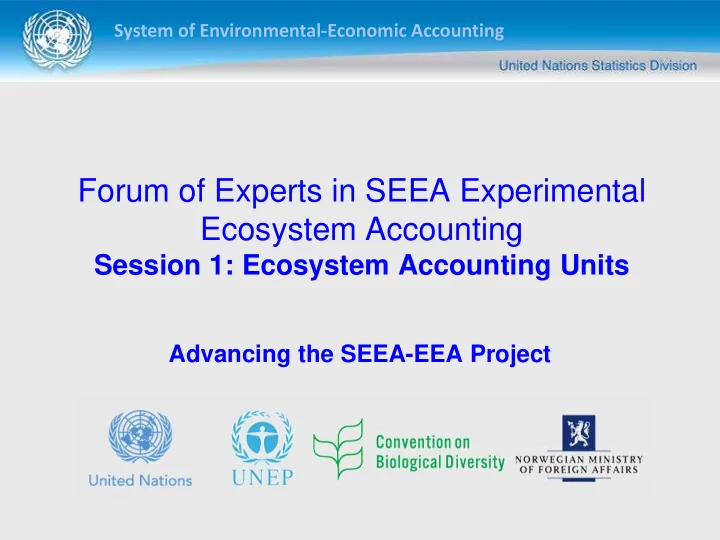

System of Environmental-Economic Accounting Forum of Experts in SEEA Experimental Ecosystem Accounting Session 1: Ecosystem Accounting Units Advancing the SEEA-EEA Project
System of Environmental-Economic Accounting Overview: Spatial units 1. Why spatial units? 2. Criteria for spatial units 3. The SEEA-EEA representation 4. Issues 5. An example 6. Recommendations for testing 7. Recommendations for further research
System of Environmental-Economic Accounting Why spatial units? Why? • Units + classifications = structure • Accounting needs statistical units about which information is compared and aggregated ▫ e.g., business statistics are built on locations, establishments, companies and enterprises • Need a common definition of Spatial Units for all accounts (Assets, Condition, Services, Water, Carbon, Biodiversity…) ▫ i.e., scale, compile, analyse, compare and report on same spatial units • Information is collected on many spatial levels ▫ Different information available at different levels ▫ Needs to be consolidated and compiled 3
System of Environmental-Economic Accounting Criteria for spatial units (provisional) Available globally & frequently Homogenous at some level • Represent “optimal units” in terms of patterns • With respect to ecosystem services (processes?) Represents all ecosystem types, including gradients between them (ecotones) Hierarchical & scalable MECE : M utually E xclusive, C ollectively E xhaustive Time-invariant? 4
System of Environmental-Economic Accounting The SEEA-EEA representation Three levels: hierarchical and mutually exclusive: 1. Basic Spatial Unit (BSU): Pixel or grid cell 2. Land Cover Ecosystem Functional Unit (LCEU): Homogenous according to criteria (e.g., cover, slope, drainage area, elevation…) • Consolidate for tables by LCEU type 3. Ecosystem Accounting Unit (EAU) • For reporting (e.g., sub- drainage area, administrative area…) 5
System of Environmental-Economic Accounting Issues Does it represent all ecosystems? • If only land cover: 1. How to treat freshwater, coastal and marine? – Upstream/downstream, benthic vs pelagic 2. May exclude vertical dimension – Wetlands, soil, mountain areas 3. Not homogenous for conditions: quality, management regime, use, ownership 4. Excludes connective phenomena: – airsheds, migration routes, water networks… 5. Classification may exclude ecotones 6
System of Environmental-Economic Accounting More issues Homogenous? 6. LCEUs may not represent “optimal” unit in terms of capturing spatial patterns 7. Large BSUs may hide important patterns ▫ “averaging” may introduce unnecessary uncertainty 8. How to deal with other sources of uncertainty: spatial interpretation? If based only on land cover, LCEUs are not homogenous “ecosystems” from an ecological perspective 7
System of Environmental-Economic Accounting An example… 8
System of Environmental-Economic Accounting An example… 9
System of Environmental-Economic Accounting An example… 10
System of Environmental-Economic Accounting Recommendations for testing Use multiple criteria to delineate LCEUs • e.g., land use, ownership, hydrology, infrastructure networks, topography, protected areas, species habitats • e.g., existing ecological classifications Test other “intermediate” spatial units: • e.g., landscape, viewscape, river units, coastal and marine units Maintain data at the appropriate scale rather than transforming to one scale • e.g., as above scale for specific analysis Test effects of BSU size • e.g., compare interpretation and results of 30m vs 1km Test land cover data from alternative sources • e.g., different sensors & seasons, recent aerial photography, ground truthing 11
System of Environmental-Economic Accounting Recommendations for testing Link spatial levels with appropriate information, e.g., 12
System of Environmental-Economic Accounting Recommendations for testing Report sources of error in spatial data • Ground-truthing to minimize interpretation errors • Record uncertainty in underlying data Assess how spatial units, scaling and aggregation are treated in spatial ecosystem services models 13
System of Environmental-Economic Accounting Recommendations for research Develop coherent approaches for treatment of: • freshwater, coastal, marine (benthic, pelagic) ecosystems • connective phenomena (airsheds, hydrological networks, disjoint habitats) • uncertainty in land cover interpretation Develop link between soil classification and ecosystem condition and capacity Research on “optimal” spatial units for ecosystem accounting that meet the criteria suggested (service providing units?) 14
System of Environmental-Economic Accounting Conclusions The existing approach (BSU, LCEU, EAU) is a pragmatic starting point if only land cover data are available Meets many criteria: Availability Homogeneity Representativeness Hierarchical & scalability MECE Time-invariance Testing can work around some of the issues, but research can develop better solutions… 15
System of Environmental-Economic Accounting Suggestions for breakout groups Priority issues, criteria, options for testing of Spatial Units in accounts for: 1. Land/Asset (delineation criteria, measurement of error) 2. Water (freshwater, coastal, marine, wetlands, quality) 3. Carbon (including stock, sequestration) 4. Biodiversity (indices, species, habitats) 5. Condition & Capacity (quality, biophysical) 6. Services (provisioning, regulating, cultural) 16
System of Environmental-Economic Accounting Acknowledgements This project is a collaboration of The United Nations Statistics Division, United Nations Environment Programme and the Secretariat of the Convention on Biological Diversity and is supported by the Government of Norway.
Recommend
More recommend